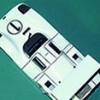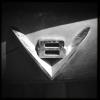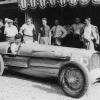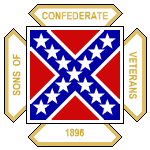
Track surfaces
#1

Posted 11 October 2003 - 21:09
I can only assume that the early French Grands Prix were run on anything but asphalt. Was Montlhery the first French GP track paved in its entirety? Was Monza the first permanent road course of all to offer its drivers a fully paved surface? What about other road races, especially the major Grands Prix?
Advertisement
#2

Posted 12 October 2003 - 07:49
At one time, I think the Monaco circuit included a section that was tiled (down towards the Gasworks??).
The RAC Blue book used to (maybe still do, I don't have the current one) specify in the circuit directory the nature of the surfaces. Presumably this was based on information as known or supplied, since the descriptions were variously generic, specific or not given at all. E.g: 'Tarmacadam'; 'Macadam'; 'Asphalt'; 'Resmat'; 'Delugrip'; 'Bitmac'; 'Belmac'; 'Fine cold asphalt'; 'Friction course tarmac'.
#3

Posted 12 October 2003 - 08:42
Originally posted by Rob G
Was Monza the first permanent road course of all to offer its drivers a fully paved surface?
A good occasion for me to jump on board with a suppelementary question. I always wondered about this picture

which I identified (very surely) as Hans Stuck at Monza in 1949. So a shot from the pit-lane perhaps or was there indeed a section of the track with cobblestones?
And for the 1903 Gordon Bennet race some parts of the (unsealed) track were soaked with a mixture of 5% petrol in ammonium and water called "Westrumit" to avoid the usual clouds of dust, in particular on passages through villages. So does "mud" count for another type of track surface?
#4

Posted 12 October 2003 - 09:10
(When did the name 'Parabolica' first appear?)
#5

Posted 12 October 2003 - 09:36
When these blocks were lifted during construction of the Pista de Alta Velocita speedbowl 1954-55 they were re-used joining others already surfacing much of the paddock area. The Curva Parabolica of modern times adopted its line during the modifications demanded by construction of the speedbowl, 1954-55.
This question of road surface is actually fascinating. When indeed was the first tarmac-surfaced 'circuit' used for competition? As late as 1948 even the Watkins Glen road course in as well developed a nation as the USA included an oil-sealed dirt-road section and certainly early postwar Mille Miglie included unsurfaced sections of road in wartorn regions of Italy. The Coppa d'Oro delle Dolomiti included gravel road sections as did myriad other events in Europe. Sections of the Reims-Gueux and Rouen les Essarts road circuits also included famously well-photographed cobbled hairpins - at Thillois, Nouveau Monde and Paradis corners for example - and in fact there was hardly a French or Belgian (or Swiss) public road circuit which did not include some stretches surfaced with stone setts, pavee or cobbles - call them what you will. Australia and New Zealand? Well...I'm sure we're about to learn...
DCN
#6

Posted 12 October 2003 - 12:48
Who, me?Originally posted by Doug Nye
Australia and New Zealand? Well...I'm sure we're about to learn...
The first road circuit used in NZ, in 1933, was gravel surfaced
The airfield circuits which led the real birth of road racing were what in that part of the world we call sealed, or tar-sealed, which I guess means tarmac'd.
The Dunedin course (from 1953) included a short unsealed (ie, gravel) section, though I think think this was sealed around 1957
The 1.4-mile main straight at Southbridge, used for two national meetings in 1957, was gravel.
Otherwise I can't think of any other major NZ circuits that weren't sealed
Australia had regular circuit-racing long before NZ did, much of it on gravel, but others can comment on them better than I can
#7

Posted 12 October 2003 - 15:17
#8

Posted 12 October 2003 - 23:18
-William
#9

Posted 12 October 2003 - 23:52
Before 1955 GP Porphyry Curves (Curve in Porfido, in Italian) where replaced by a new bend with a parabolic shape (if you look it on a map).Originally posted by 2F-001
(When did the name 'Parabolica' first appear?)
There is a big confusion about this, because many people believe that "parabolic" means "banking", but Curva Parabolica at Monza is flat and it mustn't be confused with Curva Sud Alta Velocità (High Speed Track South curve).
By the way, Curva Parabolica's design was ispired to parabolic curve on Circuito della Fascia d'Oro - Brescia, used for Italian GP in 1921.
There is still a section of the track that still surfaced as in 1939: it's North East curve, on Pirelli abandoned track. You can look at it on my photo #5; this is a thumbnail:

Click on this thumbnail to open my page, where you can find bigger photos
These tiles were made using concrete coming from demolition of the old high speed track, after 1938 Italian GP.
Ciao,
Guido
#10

Posted 13 October 2003 - 02:55
And the course at San Francisco for the that had wood planks for part of the course. What was that, the 191? Vanderbilt Cup (excuse the normal checking, but I'm ill with the flu).
Originally posted by WDH74
Just hazarding a guess in the absence of any real facts, but I think that most non-dirt ovals in America have been asphalted since the resumption of racing after the war. I've never seen one in concrete
At one time yes, dirt ovals were being asphalted over at a terrific rate into the 1960's, but that swung back the other direction in the 1980's. Dirt tracks are cheaper to build, and coupled with the fact that dirt track racing is often less expensive, there was a real Renaissance of dirt tracks and dirt track racing. So much so, that some tracks that had asphalted in the 1950's and 1960's went so far as to tear up the asphalt and revert to dirt!...and some tracks that had opened as asphalt brought clay in and covered the surface to convert to dirt. With the boom in NASCAR's popularity, there has been a building boom of asphalt tracks in recent years, but conversions seem few and far between anymore.
I'll try to get some exact figures from Allan E. Brown on this.
And Bristol, Dover Downs and Nashville are concrete.
Jim Thurman
#11

Posted 13 October 2003 - 09:04
Originally posted by David McKinney
.....Australia had regular circuit-racing long before NZ did, much of it on gravel, but others can comment on them better than I can
Who me?
Well, though you've been following racing in Australia longer than I have, David, I guess you haven't seen as many of the circuits.
Gravel (or dirt) in their entirety: Bathurst, 1938; Phillip Island 'triangle' circuit, Phillip Island original GP circuit until c1933; Benalla (I assume); Oxley; Heit Park; Lake Perkolilli; Woody Point.
Oil bonded dirt*: Dooen, Dowerin, Undera, Pound Hill 1956/7.
* Some gravel roads were partially oil bonded for racing. These aren't included.
Partly oil bonded, part sealed: Pound hill after 1957; Tarrawingee.
Partly gravel/dirt, partly sealed: Albany; Phillip Id c1933-on; Port Elliot/Victor Harbor; Wirlinga-Thurgoona; Strathpine; Towac after the circuit broke up during the Nov. 1965 meeting.
Grass: Corio; Nar Nar Goon; Kilmore.
The first wholly sealed circuit in Australia was Lobethal in 1938.
There may have been some of the Western Australian circuits which mixed gravel and bitumen (or even concrete) apart from Albany, but I think most of them were all bitumen - at least since 1950 or so.
There is another type of surface... schrapnel-laden bitumen, as found on airstrips used for racing. Leyburn, Marsden Park, probably Mt Druitt's earliest renditions, Mooliabeenie and a few others had this.
Concrete? Point Cook and probably Fishermen's Bend. Parts of Nowra, possibly.
#12

Posted 13 October 2003 - 15:07
I think they were the kind of stone surface that laid on the corners until the Mid Fifties?
If someone crashed on that kind on surface, It must have been very hard!
Paul Hooft
#13

Posted 13 October 2003 - 22:58
-William
#14

Posted 14 October 2003 - 00:29
This is exactly what my photo shows (see thumbnail on my previous post). I'm quite sure that this concrete tiles laid there until late 1938/1939, as they came from demolition of the old High Speed track (late 1938).Originally posted by paulhooft
I was a t Monza last years summer and saw that the Corner of the Old Formula Junior Circuit (it is close to the inside of the Curva Grande had a surface of very rough Stones.
I think they were the kind of stone surface that laid on the corners until the Mid Fifties?
Ciao,
Guido
#15

Posted 14 October 2003 - 00:57
There's a marvelous photo of an in-progress race that shows a couple of intrepid spectators watching . . . Watching with their heads poked up through gaps between the boards!Originally posted by WDH74
Jim-I've read somewhere about dirt ovals being paved over and vice versa. I sort of meant that new tracks, that were not originally going to be dirt or clay, were usually asphalt, but I temporarily forgot the English language. Plus, I completely blocked out the prewar board tracks, like Beverly Hills, Maywood, etc. There's an amazing picture in Griffith Borgeson's "The Golden Age of the American Racing Car" of the competitors and a couple of cars posing for a group photo on the front straight of a board track. The surface is covered in scars and gigantic splinters. Dunno how they did it!
-William
#16

Posted 14 October 2003 - 01:54
The past couple of years the World of Outlaws have run at Bristol. That involves trucking in thousands of loads of dirt and dumping it on the existing concrete track, reducing the banking by about half in the process. Then when the weekend is over they shovel it back up and take it away.Originally posted by WDH74
Jim-I've read somewhere about dirt ovals being paved over and vice versa.
2F-001, I have seen photos of the Monaco track with a sort of tiled surface along the harbor.
#17

Posted 14 October 2003 - 15:11
I was a t Monza last years summer and saw that the Corner of the Old Formula Junior Circuit (it is close to the inside of the Curva Grande had a surface of very rough Stones.
I think they were the kind of stone surface that laid on the corners until the Mid Fifties?
This is exactly what my photo shows (see thumbnail on my previous post). I'm quite sure that this concrete tiles laid there until late 1938/1939, as they came from demolition of the old High Speed track (late 1938).
Ciao,
Guido
Yes That were the stone I saw in the corner
I wonder if they were at Curva Del Valione when Alberto Ascari Crashed in may 1955??
Paul Hooft
#18

Posted 14 October 2003 - 15:40
I don't know; if I have to guess I would say NO, but I have no evidence about it, so I may be wrong!Originally posted by paulhooft
I wonder if they were at Curva Del Valione when Alberto Ascari Crashed in may 1955??
If I discover anything, I let you know!
Ciao,
Guido
#19

Posted 14 October 2003 - 21:51
The same in ball based sports... a "parabolic shot", we say when we see a trajectory usually with a relatively straight first part, a curve, and a less straight last part.
Yes, this is just a silly post, but it intrigues me
Advertisement
#20

Posted 15 October 2003 - 00:49
I think that this is because a confusion between Curva Parabolica and banking of south curve on high speed track (of course I'm talking about Monza), that are very close and they both finish on the same straight.
I have no precise drawings of Curva Parabolica, but it should have a real (half) parabolic shape. Maybe somebody could calculate also its equation, it shouldn't be too difficult
Ciao,
Guido
#21

Posted 06 August 2009 - 23:15
At one time yes, dirt ovals were being asphalted over at a terrific rate into the 1960's, but that swung back the other direction in the 1980's. Dirt tracks are cheaper to build, and coupled with the fact that dirt track racing is often less expensive, there was a real Renaissance of dirt tracks and dirt track racing. So much so, that some tracks that had asphalted in the 1950's and 1960's went so far as to tear up the asphalt and revert to dirt!...and some tracks that had opened as asphalt brought clay in and covered the surface to convert to dirt.
Hi Jim,
There was an example in Australia of a speedway that changed its surface. The Liverpool speedway in Sydney opened in 1967 as a dirt track. Circa 1974 the dirt track was covered over in asphalt due to the popularity of sedan racing. By the mid 1980's, sedan racing was on the wane, and sprintcars were the number one category. So the asphalt track was ripped up and replaced by a clay track, which stayed until the speedway was closed in 1989.
#22

Posted 07 August 2009 - 18:04
The 1950s road races in "downtown" Aspen, Colorado, were run on dirt streets, and various ice races were held on a frozen Georgetown Lake, a stone's throw from the 1950s Georgetown Hillclimb.
Frank
Edited by fbarrett, 07 August 2009 - 18:05.
#23

Posted 08 August 2009 - 03:49
"Dirt is for Racing on - Tar Seal is for Getting There"
#24

Posted 08 August 2009 - 03:54
non-dirt ovals in America have been asphalted since the resumption of racing after the war. I've never seen one in concrete,
Dover, Delaware. The Monster Mile.
#25

Posted 08 August 2009 - 05:26
Hi Graham. I'm surprised that didn't catch on more in Australia. It certainly took off stateside. It varied from paved tracks dumping dirt on top of the pavement (like I-70 in Odessa, Missouri, which eventuually took the dirt off again) to completely tearing up the asphalt (like Bakersfield Speedway).Hi Jim,
There was an example in Australia of a speedway that changed its surface. The Liverpool speedway in Sydney opened in 1967 as a dirt track. Circa 1974 the dirt track was covered over in asphalt due to the popularity of sedan racing. By the mid 1980's, sedan racing was on the wane, and sprintcars were the number one category. So the asphalt track was ripped up and replaced by a clay track, which stayed until the speedway was closed in 1989.
#26

Posted 08 August 2009 - 11:17
When you say Bakersfield Speedway I take it you mean Bakersfield Cal. I was there in 1977 at a 1/2 mile pavement track and it had quite steep banking, can't remember the name of the track but it was new. Went to two CRA sprint car shows there. One show was won by Lee James in a spring front car. Is that the track you are refering to in your recent post ?
Peter
#27

Posted 09 August 2009 - 01:41
No, that was Mesa Marin Raceway, which operated from 1977 through 2005, east of Bakersfield. Bakersfield Speedway is the 1/4 (now 1/3 mile) oval in Oildale, north of Bakersfield, that opened in 1947 and is still operating.Jim.
When you say Bakersfield Speedway I take it you mean Bakersfield Cal. I was there in 1977 at a 1/2 mile pavement track and it had quite steep banking, can't remember the name of the track but it was new. Went to two CRA sprint car shows there. One show was won by Lee James in a spring front car. Is that the track you are refering to in your recent post ?
Actually, Mesa Marin opening pretty much looked to spell the end of the older track until Spud Simkins decided to tear up the asphalt and go back to dirt.
#28

Posted 09 August 2009 - 10:36
#29

Posted 10 August 2009 - 21:26
And, I believe it as the official program photograph for the event has the trucks sitting on pit lane.
So we might say it was a dirt track circuit the morning of the event and finished the day as asphalt.
WOW, the 1960's were a very interesting time in motorsports history!
Henry
#30

Posted 10 August 2009 - 21:47
Yep, closed at the end of 2005 and was plowed up for a housing development not too long afterwards.Thanks Jim, I take it that Mesa Marin is no longer operating
#31

Posted 10 August 2009 - 22:15
And Bristol, Dover Downs and Nashville are concrete.
Jim Thurman
Bristol was once covered with dirt temporarily for a World of Outlaws Sprint Car race .
#32

Posted 10 August 2009 - 22:52
Short track racing is doing as good as ever, while big track racing, road and oval, is trying to, successfully, screw itself.
Edited by Bob Riebe, 10 August 2009 - 22:52.
#33

Posted 11 August 2009 - 09:21
A 3/8 mile track about fifty miles from here just tore out the pavement this year and went back to dirt, and about fifty miles east of here a brand new 1/2 mile dirt track just opened.
Short track racing is doing as good as ever, while big track racing, road and oval, is trying to, successfully, screw itself.
Yes Bob, we are headed back to the good ole days with local dirt tracks having a lot of success.
Henry





















